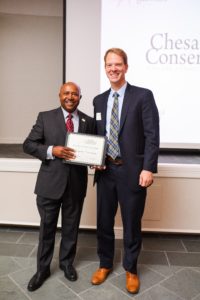Chesapeake Conservancy Honored by Virginia Environment Endowment
“Partners in Excellence” Recognition for Innovative Conservation Technology
Annapolis, MD – At a ceremony in Richmond, VA last week, the Virginia Environmental Endowment (VEE) celebrated its 40th anniversary by recognizing 22 Partners in Excellence, including the Chesapeake Conservancy, the primary nonprofit partner supporting the Captain John Smith Chesapeake National Historic Trail.

VEE Board member Blair Wimbush with Joel Dunn, President and CEO Chesapeake Conservancy.
Over its 40-year history, VEE has partnered with nearly 500 nonprofit organizations, universities, government agencies, schools and communities. Of those, 22 were selected as Partners in Excellence honorees and awarded $1,000 in recognition of their contributions to Virginia’s environment. In addition, VEE made a $10,000 grant to a documentary being developed by a nonprofit film organization on the late U.S. District Court Judge Robert R. Merhige Jr. as a special recognition for his role in establishing the Endowment.
“Over the past 10 years, the Conservancy has quickly gained recognition, in particular, for its cutting-edge efforts in landscape-based conservation and use of innovative technologies,” VEE Executive Director Joe Maroon said. “VEE was an early supporter of the Conservancy and is currently partnering with the Conservancy on the development of a watershed-wide analysis of the James River watershed that will provide critical information on the most effective places to invest in pollution reduction practices.”
“We are so fortunate to have a philanthropic partner like VEE that embraces the brave, new world of data-driven conservation. With VEE’s support, we are helping our partners use data as a powerful lens to identify the best conservation opportunities that enhance water quality. VEE’s creative and hands-on philanthropy has been a major factor in our success,” Chesapeake Conservancy President and CEO Joel Dunn said.
Through a challenge grant from VEE, Chesapeake Conservancy is leveraging high-resolution land cover data and flow path mapping in the James River watershed to determine where best management practices could most effectively deliver water quality and conservation benefits.